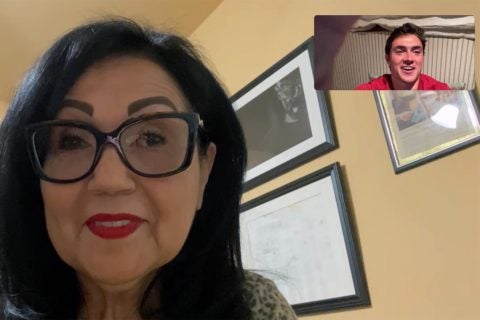When Grandpa can’t figure out FaceTime: Students teach tech to connect to older adults
Smartphone support and health advice helped seniors and USC students from seven health-related disciplines get through the pandemic.
If you’re looking for Jake Pham and Eloise Martinez, you might find them together on FaceTime. The physical therapy student and senior are separated by 50 miles and almost 50 years. Their connection should be in person, but fate had other plans when the pandemic hit.
“With Eloise, I’ve been very fortunate that she and I had a great connection,” Pham said. “There’s good chemistry and we bonded very easily, so we talked for a minimum of one hour. Sometimes we go up to three hours a week.”
Pham, a 25-year-old physical therapy student at USC and Martinez, a 72-year-old retiree from Fontana, Calif., were brought together in part by the pandemic.
Pham is one of 91 students who took part in the USC Interprofessional Geriatrics Curriculum during the past academic year.
The curriculum, housed at the Keck School of Medicine of USC, unites students from seven disciplines: medicine, occupational therapy, physical therapy, physician assistant, psychology, pharmacy and social work. A team is formed along the professional model where health experts from various disciplines support an older partner.
We consider our older adult partners to be our teachers.
Cheryl Resnik
“We consider our older adult partners to be our teachers,” said faculty adviser Cheryl Resnik, associate professor of clinical physical therapy at the USC Division of Biokinesiology and Physical Therapy. “When COVID struck, we had an older population at high risk. People were isolated and they needed a human connection, but we couldn’t put seven students and the faculty member in somebody’s home so we had to rework it.”
Bonnie Olsen, professor of clinical family medicine at the Keck School of Medicine, leveraged a grant to help get devices into the hands of seniors who needed them. Olsen, who heads the larger Geriatric Workforce Enhancement Program, drove the quick turn from in-person to online support.
Wanted: a little help with FaceTime
Pham, an inherently patient man who finds energy in human connection, managed to bridge gaps between operating systems and generations.

“It’s kind of along the same lines as working with my parents or working with patients in a clinic — I’ve learned to be a little bit more understanding,” he said. “With Eloise, I’d put my phone on speaker and I’d be very descriptive. I’d say ‘look for this icon’ or ‘look for the green arrow.’ Eloise is sharp. After I walked her through it, she called me on FaceTime. That’s how we started.”
“My problem was I had a device and I had no idea what I could do with it,” said Martinez, whose husband Alex also takes part in the Interprofessional Geriatrics Curriculum. “Jake’s got me to where I can FaceTime with my daughter and see my grandson in New Mexico.”
Many hours and conversations later, Pham and Martinez stay in touch. Now that both are vaccinated, they hope to someday meet in person.
USC’s Interprofessional Geriatrics Curriculum helps to break down siloes
Conducted in at least five languages, including Russian, Korean and Chinese, the curriculum is guided by veteran faculty advisers like Seyed Parham Khalili, clinical assistant professor of family medicine at the Keck School of Medicine.
“We’re stronger together, and better informed, when we combine our strengths,” he said. “That’s one of the other major benefits of the program. It’s a confluence of ideas. It’s teaching them to learn on their own how to work interprofessionally and how to break down these unfortunate silos between health professionals.”
Throughout the past academic year, teams met online with faculty advisers to talk about patient care. Several brought up concerns about their older adult partners who were homebound and had limited mobility. Physical therapy students offered recommendations for safe exercises while students from the USC Suzanne Dworak-Peck School of Social Work contributed ideas about how to screen for mood disorders.
We’re stronger together, and better informed, when we combine our strengths.
Seyed Parham Khalili
Others helped provide reassurance and information as pandemic rumors ran rampant.
Physical therapy student Kristen Ishii connected with an older adult who was fearful about the disease and vaccinations.
“Some of her friends had warned her she could die from the vaccine because of underlying conditions,” Ishii said. “I tried to compare it to another common vaccine, the flu shot. Based on her expression, the light bulb was starting to turn on. I think the reassurance of having someone she trusts, outside her friend circle, was helpful.”
For USC students, educating older adults goes both ways
Henry Steyer, a medical student at the Keck School of Medicine, plans to practice primary care, often the first point of contact for a patient. Over the past year, he’s checked in with 72-year-old Silvia Padilla at least once a month.
“People have been dealing with really hard things during this pandemic,” Steyer said. “Silvia has a big family, but she hasn’t been able to see them. She’s used to cooking for others and helping others, so she misses that, but she’s always able to find the silver lining.”
Padilla has little trouble with tech. She and Henry go over her grocery lists and daily routines on Zoom. They talk about exercise, stress, nutrition and the latest COVID news. They sometimes text between video chats.
“I felt like I had known him for a long time,” Padilla said. “We’d talk a lot about how I felt throughout that week, and he would coach me through.”
The benefits go both ways.
“Just talking is helpful to education as well,” Steyer said, “because that’s part of what I’m going to do for the rest of my life.”



